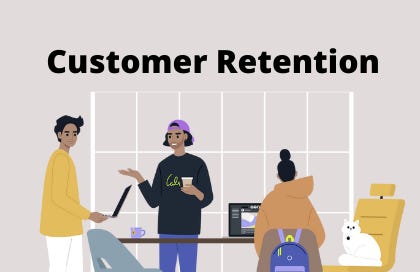What is customer retention?
Customer retention refers to the ability of a company or product to retain its customers over some specified period. High customer retention means customers of the product or business tend to return to, continue to buy, or in some or other way.
According to research from Harvard Business School, increasing customer retention rates by only 5% increases a company’s profits by 25-95%.
Why is customer retention important?
Being mindful of customer retention matters because it helps you understand how loyal and satisfied your customers are, how strong your customer service is, and if there are any red flags that may turn off potential customers.
Focusing on customer retention pays dividends in the long run:
Lower cost compared to customer acquisition – As Econsultancy reports, 82% of companies state that customer retention is far cheaper than customer acquisition, yet many companies spend much more on acquisition instead of nurturing customers they already have.
Increased AOV – Not only is it much more cost-effective to retain current customers, but those shoppers are also willing to spend more as time goes on. Research shows that loyal customers are 23% more likely to spend with you than the average customer.
Increased profits – Taking care of customers and keeping them over time will also have a positive impact on your bottom line. Data shows that increasing customer retention by 5% can increase profits anywhere from 25% to 95% and that existing customers provide 65% of a company’s business.
Brand ambassadors – The best thing about loyal customers is that they tend to share their positive experiences, thus becoming your brand ambassadors. That’s priceless. According to Yotpo, 60% of consumers talk about a brand they’re loyal to with their family and friends. As word of mouth increases exponentially, customer retention is a must-have for your business.
How do you measure your customer retention rate?
Customer retention rates are most often reported as a percentage of total customers.
To calculate your retention rate, you must determine how you plan to measure it. Will it be based on your total number of customers or your total revenue? Will you measure it by month, quarter, year, or all-time? Take a moment to record your definition. Once you decide how you will measure your product’s retention, calculate these three numbers:
The number of customers at the start of that period
The number of customers at the end of that period
The number of customers acquired during that period
You can measure your customer retention by plugging those numbers into the following equation.
The customer retention equation:
CRR = [(Customers at end of period - New customers acquired during this period) / Total customers at the start of the period] x 100
For example, if you had 120 customers at the end of the period, 104 at the beginning, and acquired 20 during that time, your equation would look like this:
((120 – 20) / 104) x 100 = 96% customer retention rate
5 Customer retention strategies that work
Successful customer retention involves more than giving the customer what they expect. Generating loyal advocates of the brand might mean exceeding customer expectations.
Improve user onboarding One key reason for churn is that users simply do not understand how to get the most out of a product. During the onboarding process, a company should ensure that the client is aware of the key benefits that a product offers. One great way to do this is through training sessions that teach users about best practices and standardized workflows. Giving your customers the tools they need to succeed will maximize customer satisfaction and decrease churn over time.
Use client feedback to find weaknesses and constantly improve User feedback is absolutely essential when it comes to improving customer retention. This is relatively self-evident, as the way a client feels and perceives your brand ultimately determines whether they will become a loyal customer or jump ship.
Businesses need to gather accurate feedback from their users. This can be accomplished through satisfaction surveys or a feedback bar on the website or platform where users can submit feedback while they are using the product.
Use subscriptions to keep customers coming back Another customer retention strategy is using a subscription model. According to McKinsey, “15 percent of online shoppers have signed up for one or more subscriptions to receive products on a recurring basis.”
Use automated emails to encourage inactive users to take action One way to increase retention is by ensuring customers are as active as possible. If a user has remained inactive for a while, an automated email through your CRM system can induce this user to take action.
Create a personalized customer loyalty program A customer loyalty program is a great way of giving something back to customers while at the same time offering a chance to build a personal connection.



